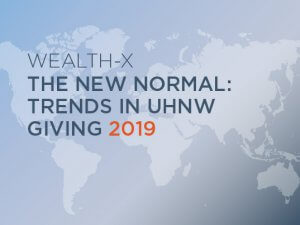What is the Report?

The report focuses on the philanthropic interests and inclinations of Ultra High Net Worth (UHNW) Individuals around the globe. It looks at their giving patterns, areas of philanthropic focus, as well as other trends.
The report defines UHNW as those with a net worth of $30M+, and UHNW individuals who have demonstrated interest in philanthropy with gifts of at least $50K in a five year period from 2014-2018.
What are the Key Findings from the Article?
- In 2018, Ultra High Net Worth Individuals gave $153B to philanthropic causes. This total includes UNHW in North America, which gave almost half of that total with Europe coming in second, followed by Asia. North America’s share is credited to the strong philanthropic history while Europe and Asia are developing their philanthropic cultures.
- Collaboration is key for relationships with UNWH individuals. Ultra-wealthy donors want to “co-create” with their nonprofits. They want to volunteer in different capacities including serving on boards.
- But collaboration isn’t just between donors and nonprofits. Ultra-wealthy donors are working with advisors and/or bringing in family and others for decision-making. There’s even interest in pooling resources or finding peer groups, like the Founder’s Pledge.
- Generational differences in philanthropy are becoming apparent. The next generation is more active in giving and volunteering at an earlier age and they give to fewer causes in comparison to their elders.
- Education is the favorite area for support by the ultra-wealthy. Almost 9 in 10 people directed their money to educational causes with a minimum gift of $50K. The next three most popular areas were social services, healthcare and medical research, and arts and culture. In contrast, the 2019 Giving USA report found that the top three giving areas in the US were Religion, Education, and Human Services. Arts & Culture was 8th.
What Can I Do as a Result?
- Approach ultra-wealthy individuals with ideas on how to collaborate. Find out what their passions are and consider finding a position on a board, committee, etc. that may be of interest to them.
- Recognize that philanthropic decisions might not be made individually, but collaboratively. A single person may not be making the decision about a gift; the decision may include a spouse or family members. Ask your prospect how they make financial decisions and make sure to include all decision-makers.
- Consider offering opportunities for gifts with pooled resources or other collaborative giving. Not only do people make collective decisions about philanthropy, they are giving together. Figure out how your organization can make it easier for families and/or friends to give together, whether it’s pooling money into a single fund, encouraging giving circles or other collaborative giving vehicles.
- Figure out ways to engage younger UHNW individuals early on. They may not be able to give as large a gift right now as older generations can, but your organization will want their loyalty for future gifts in 5-15 years.
Additional Resources
- UHNW Giving Philanthropy Report | Wealth-X 2019
- Giving USA Summary 2019 | Giving USA
- Not Asking for Millions? Why Should You Care About HNWIs? | Jennifer Filla blog 2018
